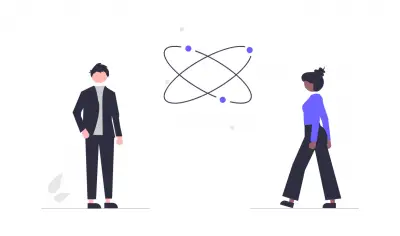
Physics Questions and Answers
If you want to learn more about the nature and properties of matter and energy or you're simply preparing for a Physics exam, these Physics past questions and answers are ideal for you.

If you want to learn more about the nature and properties of matter and energy or you're simply preparing for a Physics exam, these Physics past questions and answers are ideal for you.
at the same distance as A
six times as far.
two times as far
three times as far
Correct answer is C
No explanation has been provided for this answer.
When an electron jumps directly from an orbit of n = 4 to n = 2,
a photon is absorbed
a photon is emitted
two photons are emitted.
two photons are absorbed
Correct answer is B
When an electron jumps directly from an orbit of n = 4 to n = 2, a photon is emitted.
This is a typical scenario in atomic physics where an electron transitions from a higher energy level (orbit) to a lower energy level. During this transition, the electron loses energy, and this energy is emitted in the form of a photon. The energy of the emitted photon corresponds to the energy difference between the two energy levels, as described by the quantization of energy levels in the Bohr model of the atom.
What is the name given to the force of attraction between the nucleons in the nucleus of an atom?
Gravitational force.
Electrostatic force.
Magnetic force.
Nuclear force.
Correct answer is D
The force of attraction between the nucleons (protons and neutrons) in the nucleus of an atom is called the nuclear force or strong nuclear force. This force is responsible for holding the protons and neutrons together in the nucleus despite the electrostatic repulsion between positively charged protons. It is one of the fundamental forces in nature and plays a crucial role in the stability of atomic nuclei.
is positively charged and is concentrated in a tiny volume
contains protons and electrons distributed in a tiny volume.
is concentrated in a tiny volume and contains alpha particles.
is distributed in a tiny volume and emits alpha particles.
Correct answer is A
The Rutherford scattering experiment showed that the nucleus of an atom:
is concentrated in a tiny volume and is positively charged.
In the experiment, when alpha particles were fired at a thin gold foil, most of the alpha particles passed straight through, but a few were deflected considerably. This result led Rutherford to conclude that the positive charge of the atom is concentrated in a small, dense nucleus at the center of the atom. The fact that some alpha particles were deflected strongly indicated that there was a positively charged nucleus within the atom. This experiment was crucial in developing our understanding of atomic structure and led to the model of the atom with a central nucleus containing protons and neutrons, surrounded by electrons.
150J
200J
50J
100J
Correct answer is C
\(M_{bullet}\) = 0.05kg, \(V_{bullet}\) = 200m/s, \(M_{block}\) = 0.95kg and \(V_{block}\) = 0
for an inelastic collision
\(M_{bullet} \times V_{bullet} + M_{block} \times V_{block} = (M_{bullet} + M_{block})\)v
0.05 x 200 + 0.95 x 0 = ( 0.05 + 0.95)v
10 + 0 = v
v = 10m/s
K.E of the block = \(\frac{1}{2}mv^2\)
K . E = \(\frac{1}{2} \times(0.05 + 0.95) \times10^2\) ( bullet now part of the block)
K . E = \(\frac{1}{2} \times1 \times100\)
= 50J